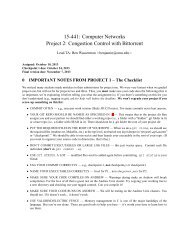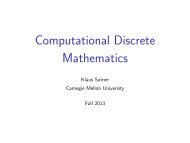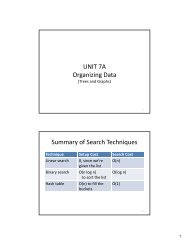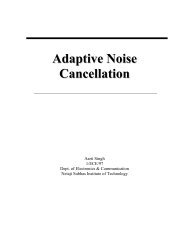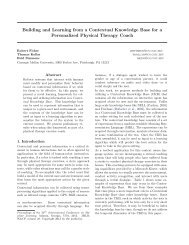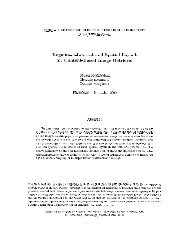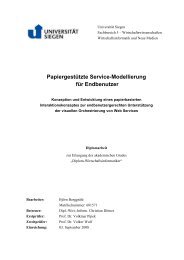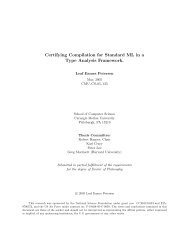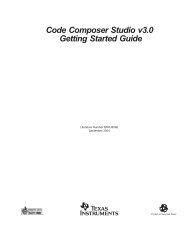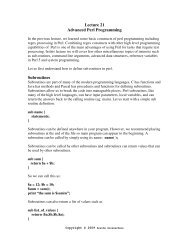CDM - Carnegie Mellon University
CDM - Carnegie Mellon University
CDM - Carnegie Mellon University
Create successful ePaper yourself
Turn your PDF publications into a flip-book with our unique Google optimized e-Paper software.
<strong>CDM</strong><br />
Algorithms for propositional Logic<br />
Klaus Sutner<br />
<strong>Carnegie</strong> <strong>Mellon</strong> <strong>University</strong><br />
Fall 2013
1 Boolean Decision Problems<br />
<br />
SAT Solvers<br />
<br />
Refutation and Resolution<br />
<br />
Binary Decision Diagrams
Decision Problems 3<br />
Recall the standard decision problems associated with propositional formulae.<br />
Problem: Satisfiability<br />
Instance: A Boolean formula ϕ.<br />
Question: Is ϕ satisfiable?<br />
Problem: Tautology<br />
Instance: A Boolean formula ϕ.<br />
Question: Is ϕ a tautology?<br />
Problem: Equivalence<br />
Instance: Two Boolean formulae ϕ and ψ.<br />
Question: Are ϕ and ψ equivalent?
All One 4<br />
The reason it is worthwhile to distinguish between these three problems is<br />
computational complexity: given a certain representation, a particular problem<br />
can be tackled with such-and-such resources.<br />
Other than that, they are very closely related:<br />
ϕ satisfiable iff ¬ϕ not a tautology<br />
ϕ satisfiable iff ϕ,⊥ not equivalent<br />
ϕ,ψ equivalent iff (ϕ ⇔ ψ) a tautology<br />
Of course, negation or the introduction of the connective “⇔” can ruin the<br />
representation of a formula.
Boolean Functions 5<br />
As we have seen, any Boolean formula ϕ(x 1,x 2,...,x n) naturally defines an<br />
n-ary Boolean function ̂ϕ : 2 n → 2.<br />
In terms of Boolean functions, the three problems translate into<br />
f ≠ 0<br />
f = 1<br />
f = g<br />
Of course, this version obscures the representation of the functions and<br />
therefore muddles complexity issues.
Representation 6<br />
There are two important and drastically different ways to represent a Boolean<br />
function.<br />
A Boolean formula ϕ(x 1,x 2,...,x n), in particular a formula in a<br />
particular normal form such as NNF, CNF, DNF.<br />
A custom designed data structure, a so-called binary decision diagram.<br />
As we will see, the representation is critical for complexity issues.<br />
For the time being, we will deal with representations inspired by the formula<br />
perspective.
Preprocessing 7<br />
It seems reasonable to preprocess the input a bit: we can try to bring the input<br />
into some particularly useful syntactic form, a form that can then be exploited<br />
by the algorithm.<br />
There are two issues:<br />
The transformation must produce an equivalent formula (but see below<br />
about possible additions to the set of variables).<br />
The transformation should be fast.<br />
Here are some standard methods to transform propositional formulae.<br />
We will focus on formulae using ¬,∧,∨, a harmless assumptions since we can<br />
easily eliminate all implications and biconditionals.
Negation Normal Form (NNF) 8<br />
Definition<br />
A formula is in Negation Normal Form (NNF) if it only contains negations<br />
applied directly to variables.<br />
A literal is a variable or a negated variable.<br />
Theorem<br />
For every formula, there is an equivalent formula in NNF.<br />
The algorithm pushes all negation signs inward, until they occur only next to a<br />
variable.<br />
Rules for this transformation:<br />
¬(ϕ∧ψ) ⇒ ¬ϕ∨¬ψ<br />
¬(ϕ∨ψ) ⇒ ¬ϕ∧¬ψ<br />
¬¬ϕ ⇒ ϕ
As Parse Trees 9<br />
Push negations down to the leaves.<br />
¬<br />
∧<br />
∨<br />
¬<br />
¬<br />
ϕ<br />
ψ<br />
ϕ<br />
ψ<br />
¬<br />
∨<br />
∧<br />
¬<br />
¬<br />
ϕ<br />
ψ<br />
ϕ<br />
ψ
Rewrite Systems 10<br />
This is an example of a rewrite system: replace the LHS by the RHS of a<br />
substitution rule, over and over, until a fixed point is reached.<br />
Note that this requires pattern matching: we have to find the handles in the<br />
given expression.<br />
¬(p∧(q ∨¬r)∧s∧¬t)<br />
¬p∨¬(q ∨¬r)∨¬s∨t<br />
¬p∨(¬q ∧r)∨¬s∨t<br />
Also note that the answer is not unique, here are some other NNFs for the<br />
same formula:<br />
¬p∨¬s∨t∨(¬q ∧r)<br />
(¬p∨¬s∨t∨¬q)∧(¬p∨¬s∨t∨r)<br />
Conversion to NNF is a search problem, not a function problem.
Min- and Max-Terms 11<br />
So we are left with a formula built from literals using connectives ∧ and ∨.<br />
The most elementary such formulae have special names.<br />
Definition<br />
A minterm is a conjunction of literals.<br />
A maxterm is a disjunction of literals.<br />
Note that a truth table is essentially a listing of all possible 2 n full minterms<br />
over some fixed variables x 1,x 2,...,x n combined with the corresponding truth<br />
values of the formula ϕ(x 1,...,x n).<br />
By forming a disjunction of the minterms for which the formula is true we get a<br />
(rather clumsy) normal form representation of the formula.<br />
The reason we are referring to the normal form as clumsy is that it contains<br />
many redundancies in general. Still, the idea is very important and warrants a<br />
definition.
Disjunctive Normal Form 12<br />
Definition<br />
A formula is in Disjunctive Normal Form (DNF) if it is a disjunction of<br />
minterms (conjunctions of literals).<br />
In other words, a DNF formula is a “sum of products” and looks like so:<br />
(x 11 ∧x 12 ∧...∧x 1n1 )∨(x 21 ∧...∧x 2n2 )∨...∨(x m1 ∧...∧x mnm )<br />
where each x ij is a literal.<br />
In short: ∨ i<br />
∧<br />
j xij.<br />
If you think of the formula as a circuit DNF means that there are two layers:<br />
an OR gate on top, AND gates below. Note that this only works if we assume<br />
unbounded fan-in and disregard negation.
Conversion to DNF 13<br />
Theorem<br />
For every formula, there is an equivalent formula in DNF.<br />
Step 1: First bring the formula into NNF.<br />
Step 2: Then use the rewrite rules<br />
ϕ∧(ψ 1 ∨ψ 2) ⇒ (ϕ∧ψ 1)∨(ϕ∧ψ 2)<br />
(ψ 1 ∨ψ 2)∧ϕ ⇒ (ψ 1 ∧ϕ)∨(ψ 2 ∧ϕ)<br />
✷<br />
Exercise<br />
Prove that these rules really produce a DNF. What is the complexity of this<br />
algorithm?
Expression Trees 14<br />
Here is the corresponding operation in terms of the expression tree.<br />
ϕ<br />
ϕ ψ 1<br />
∧<br />
∨<br />
ψ 1 ψ 2 ϕ ψ 2<br />
∨<br />
∧ ∧<br />
Note that we have created a second copy of ϕ (though in an actual algorithm<br />
we can avoid duplication by sharing subexpressions; nonetheless the ultimate<br />
output will be large).
Example 15<br />
First conversion to NNF.<br />
¬(p∨(q ∧¬r)∨s∨¬t<br />
¬p∧¬(q ∧¬r)∧¬s∧t<br />
¬p∧(¬q ∨r)∧¬s∧t<br />
Reorder, and then distribute ∧ over ∨.<br />
¬p∧¬s∧t∧(¬q ∨r)<br />
(¬p∧¬s∧t∧¬q)∨(¬p∧¬s∧t∧r)
Complexity 16<br />
Computationally, there is one crucial difference between conversion to NNF and<br />
conversion to DNF:<br />
The size of the formula in NNF is linear in the size of the input.<br />
The size of the formula in DNF is not polynomially bounded by the size of<br />
the input.<br />
Thus, even if we have a perfect linear time implementation of the rewrite<br />
process, we still wind up with an exponential algorithm.<br />
Exercise<br />
Construct an example where conversion to DNF causes exponential blow-up.
DNF and Truth Tables 17<br />
One reason DNF is natural is that one can easily read off a canonical DNF for<br />
a formula if we have a truth table for it.<br />
For n variables, the first n columns determine 2 n full minterms (containing<br />
each variable either straight or negated).<br />
10011 ⇒ x 1x 2x 3x 4x 5<br />
Select those rows where the formula is true, and collect all the corresponding<br />
minterms into a big disjunction.<br />
Done!<br />
Note the resulting formula has O(2 n ) conjunctions of n literals each.
Example 18<br />
Unfortunately, this approach may not produce optimal results: for p∨q we get<br />
p q (p∨q)<br />
0 0 0<br />
0 1 1<br />
1 0 1<br />
1 1 1<br />
So brute force application of this method yields 3 full minterms:<br />
(p∧¬q)∨(¬p∧q)∨(p∧q)<br />
Clearly, we need some simplification process. More about this later in the<br />
discussion of resolution.
Remember? 19<br />
This is essentially the same method we used to get the expressions for sum and<br />
carry in the 2-bit adder.<br />
In a Boolean algebra, one talks about sums of products of literals instead of<br />
DNF.<br />
Hence, any Boolean expression can be written in sum-of-products form.<br />
Is there also a product-of-sums representation?<br />
Sure ...<br />
Unlike with ordinary arithmetic, in Boolean algebra there is complete symmetry<br />
between meet and join.
Conjunctive Normal Form (CNF) 20<br />
Definition<br />
A formula is in Conjunctive Normal Form (CNF) if it is a conjunction of<br />
maxterms (disjunctions of literals).<br />
The maxterms are often referred to as clauses in this context. So, a formula in<br />
CNF looks like ∧∨<br />
i<br />
j<br />
x ij.<br />
Theorem<br />
For every formula, there is an equivalent formula in CNF.<br />
Again start with NNF, but now use the rules<br />
ϕ∨(ψ 1 ∧ψ 2) ⇒ (ϕ∨ψ 1)∧(ϕ∨ψ 2)<br />
(ψ 1 ∧ψ 2)∨ϕ ⇒ (ψ 1 ∨ϕ)∧(ψ 2 ∨ϕ)
Blow-Up 21<br />
The formula<br />
ϕ = (p 10 ∧p 11)∨(p 20 ∧p 21)∨...(p n0 ∧p n1)<br />
is in DNF, but conversion to CNF using our rewrite rule produces the<br />
exponentially larger formula<br />
ϕ ≡ ∧<br />
∨<br />
f:[n]→2 i∈[n]<br />
p if(i)<br />
Exercise<br />
Show that there is no small CNF for ϕ: the 2 n disjunctions of length n must all<br />
appear.<br />
Are CNF-based (or DNF-based) algorithms then useless in practice?
Tseitin’s Trick 22<br />
No, but we have to be careful with the conversion process to control blow-up.<br />
Instead of preserving the underlying set of propositional variables, we extend it<br />
by a new variable q ψ for each subformula ψ of φ.<br />
For a propositional variable p we let q p = p and introduce a clause {p}.<br />
Otherwise we introduce clauses as follows:<br />
q ¬ψ : {q ψ ,q ¬ψ },{¬q ψ ,¬q ¬ψ }<br />
q ψ∨ϕ : {¬q ψ ,q ψ∨ϕ },{¬q ϕ,q ψ∨ϕ },{¬q ψ∨ϕ ,q ϕ,q ψ }<br />
q ψ∧ϕ : {q ψ ,¬q ψ∧ϕ },{q ϕ,¬q ψ∧ϕ },{¬q ψ ,¬q ϕ,q ψ∧ϕ }<br />
The intended meaning of q ψ is pinned down by these clauses, e.g.<br />
q ψ∨ϕ ≡ q ψ ∨q ϕ
Example 23<br />
Consider again the formula<br />
ϕ = (p 10 ∧p 11)∨(p 20 ∧p 21)∨...∨(p n0 ∧p n1)<br />
Set B k = (p k0 ∧p k1 ) and A k = B k ∨B k+1 ∨...∨B n for k = 1,...,n. Thus,<br />
ϕ = A 1 and all the subformulae other than variables are of the form A k or B k .<br />
The clauses in the Tseitin form of ϕ are as follows (we ignore the variables):<br />
q Ak :<br />
{<br />
qBk ,¬q Bk ∧A k−1<br />
}<br />
,<br />
{<br />
qAk−1 ,¬q Bk ∧A k−1<br />
}<br />
,<br />
{<br />
¬qBk ,¬q Ak−1 ,q Bk ∧A k−1<br />
}<br />
q Bk : {¬p k0 ,q Bk },{¬p k1 ,q Bk },{¬q Bk ,p k1 ,p k0 }<br />
Exercise<br />
Make sure you understand in the example how any satisfying assignment to ϕ<br />
extends to a satisfying assignment of the Tseitin CNF, and conversely.
Preserving Satisfiability 24<br />
Theorem<br />
The set C of clauses in Tseitin CNF is satisfiable if, and only if, φ is so<br />
satisfiable. Moreover, C can be constructed in time linear in the size of φ.<br />
Proof.<br />
⇒: Suppose that σ |= C.<br />
An easy induction shows that for any subformula ψ we have [ψ] σ = [q ψ ] σ.<br />
Hence [φ] σ = [q φ ] σ = 1 since {q φ } is a clause in C.<br />
⇐: Assume that σ |= φ.<br />
Define a new valuation τ by τ(q ψ ) = [ψ] σ for all subformulae ψ. It is easy to<br />
check that τ |= C.<br />
✷
Knights in Shiny Armor 25<br />
Exercise<br />
Construct a formula Φ n that is satisfiable if, and only if, the n×n chessboard<br />
has the property that a knight can reach all squares by a sequence of<br />
admissible moves.<br />
What would your formula look like in CNF and DNF?<br />
Exercise<br />
Construct a formula Φ n that is satisfiable if, and only if, the n×n chessboard<br />
admits a knight’s tour: a sequence of admissible moves that touches each<br />
square exactly once.<br />
Again, what would your formula look like in CNF and DNF?
Some Questions 26<br />
Exercise<br />
How hard is it to convert a formula to CNF?<br />
Exercise<br />
Show how to convert directly between DNF and CNF.<br />
Exercise<br />
Show: In CNF, if a clause contains x and x, then we can remove the whole<br />
clause and obtain an equivalent formula.<br />
Exercise<br />
Suppose a formula is in CNF.<br />
How hard is it to check if the formula is a tautology?<br />
Exercise<br />
Suppose a formula is in DNF.<br />
How hard is it to check if the formula is a tautology?<br />
Exercise<br />
How about checking whether a formula in DNF (or CNF) is a contradiction?
Boolean Decision Problems<br />
2 SAT Solvers<br />
<br />
Refutation and Resolution<br />
<br />
Binary Decision Diagrams
Satisfiability Testing 28<br />
Truth tables allow one to check any property (tautology, contradiction,<br />
satisfiability). But: the table has exponential size and so is useless in practice<br />
where one often deals with formulae with thousands of variables.<br />
Recall that Satisfiability testing is enough in the sense that<br />
ϕ is a tautology iff ¬ϕ is not satisfiable.<br />
ϕ is a contradiction iff ¬ϕ is a tautology iff ϕ is not satisfiable.<br />
Again, these equivalences coexist uneasily with normal forms. For example, if ϕ<br />
is in CNF then ¬ϕ can be easily converted into DNF, but CNF is far off.<br />
So for algorithms that depend on a specific form of the input there may be a<br />
problem if conversion is slow.
Normal Forms and Meaning 29<br />
It should be noted that CNF and DNF are not particularly useful for a human<br />
being when it comes to understanding the meaning of a formula (NNF is not<br />
quite as bad). But that’s not their purpose: they provide a handle for<br />
specialized algorithms to test validity and satisfiability. We’ll focus on the<br />
latter.<br />
First note that one can perform various cleanup operations without affecting<br />
satisfiability in CNF.<br />
We can delete any clause that contains a literal and its negation.<br />
We can delete any clause that contains another clause (as a subset).<br />
The last step is justified by the equivalence<br />
ϕ∧(ϕ∨ψ) ≡ ϕ
Example: CNF Tautology Testing 30<br />
Here is a very small example. We verify that Peirce’s Law<br />
((A → B) → A) → A<br />
is a tautology. Rewriting the implications we get<br />
¬(¬(¬A∨B)∨A)∨A<br />
which turns into<br />
(¬A∨B ∨A)∧(¬A∨A)<br />
By the first simplification rule we are done.
SAT Algorithms 31<br />
There is an old, but surprisingly powerful satisfiability testing algorithm due to<br />
Davis and Putnam, originally published in 1960. Modern versions of the<br />
algorithm (some of them commercial and proprietary) are still widely used<br />
today.
The Davis/Putnam Paper 32<br />
It is worth noting that the original paper goes by the title<br />
A Computing Procedure for Quantification Theory<br />
Thus, the real target is predicate logic (first order logic) rather than<br />
propositional logic. They use a refutation method based on Herbrand universes.<br />
The method produces a sequence of larger and larger propositional formulae<br />
obtained from the negation of the given formula, that each must be tested for<br />
satisfiability. If a non-satisfiable formula appears the algorithm terminates (in<br />
which case the original formula is proven valid), otherwise it continues<br />
indefinitely. Each round employs what is now the classical Davis/Putnam<br />
method.<br />
As the authors point out, their method yielded a result in a 30 minute<br />
hand-computation where another algorithm running on an IBM 704 failed after<br />
21 minutes. The variant presented below was first implemented by Davis,<br />
Longman and Loveland in 1962 on an IBM 704.
The Main Idea 33<br />
The basic idea of the propositional part of the algorithm is beautifully simple:<br />
DPLL assumes that the input formula is in CNF and performs certain simple<br />
cleanup operations – until they apply no longer.<br />
Then it bites the bullet: it picks a variable and explicitly tries to set it to “true”<br />
and “false”, respectively.<br />
Recurse.<br />
The wary algorithm designer will immediately suspect exponential behavior, but<br />
as it turns out in many practical cases the algorithm performs very well.
Davis/Putnam Algorithm 34<br />
Suppose the formula ϕ is given in CNF. We are trying to solve the decision<br />
problem Satisfiability.<br />
In this context, the disjunctions in CNF are often called clauses. Since the order<br />
of terms in a clause does not matter, one usually writes them as sets of literals.<br />
So a whole formula in CNF might be written as<br />
{x,y,u},{x,y,u},{x,u}<br />
A clause is a unit clause iff it contains just one literal.<br />
Note that an empty clause corresponds to ⊥: there are no literals that one<br />
could try to set to a truth value that would render the whole clause true.
Unit Clause Elimination (UCE) 35<br />
Unit clauses are easy to deal with:<br />
The only way to satisfy a single literal x is by setting σ(x) = 1.<br />
Note that once we decide σ(x) = 1, we can perform<br />
Unit Subsumption: delete all clauses containing x, and<br />
Unit Resolution: remove x from all remaining clauses.<br />
This process is called unit clause elimination.<br />
The crucial point is: a CNF formula ϕ containing unit clause {x} is satisfiable<br />
iff there is an assignment σ setting x to true, and satisfying ϕ ′ obtained from ϕ<br />
by UCE.
Pure Literal Elimination (PLE) 36<br />
A pure literal in a CNF formula is a literal that occurs only directly, but not<br />
negated. So the formula may contain a variable x but not x or, conversely, only<br />
x but not x.<br />
Clearly, if the formula contains x but not x we can simply set σ(x) = 1 and<br />
remove all the clauses containing the variable.<br />
Likewise, if the formula contains x but not x we can set σ(x) = 0 and remove<br />
all clauses containing the negated variable.<br />
This may sound utterly trivial, but note that in order to do PLE efficiently we<br />
should probably keep a counter for the total number of occurrences of both x<br />
and x for each variable.
More on PLE 37<br />
Here is a closer look at PLE. Let Φ be in CNF, x a variable. Define<br />
Φ + x: the clauses of Φ that contain x positively,<br />
Φ − x: the clauses of Φ that contain x negatively, and<br />
Φ ∗ x: the clauses of Φ that are free of x.<br />
So we have the partition<br />
Φ = Φ + x ∪Φ − x ∪Φ ∗ x<br />
This partition gives rise to a trie data structure.
PLE lemma 38<br />
Proposition<br />
If Φ + x or Φ − x is empty then Φ is equivalent to Φ ∗ x.<br />
In other words, one can replace Φ by Φ ∗ x: Φ is satisfiable iff Φ ∗ x is satisfiable.<br />
Since Φ ∗ x is smaller than Φ (unless x does not appear at all) this step simplifies<br />
the problem of deciding satisfiability.<br />
Of course, we get stuck when all variables have positive and negative<br />
occurrences.
The DPLL Algorithm 39<br />
Perform unit clause elimination until no unit clauses are left.<br />
Perform pure literal elimination, call the result ψ.<br />
If an empty clause has appeared, return false.<br />
If all clauses have been eliminated, return true.<br />
Splitting: otherwise, cleverly pick one of the remaining literals, x.<br />
Recursively test both<br />
ψ,{x} and ψ,{x}<br />
for satisfiability.<br />
Return true if at least one of the branches returns true, false otherwise.<br />
So this is dangerously close to brute-force search. The algorithm still succeeds<br />
beautifully in the real world since it systematically exploits all possibilities to<br />
prune irrelevant parts of the search tree.
Example 40<br />
After three unit clause elimination steps (no pure literal elimination) and one<br />
split on d we get the answer “satisfiable”:<br />
1 {a,b,c} {a,!b} {a,!c} {c,b} {!a,d,e} {!b}<br />
2 {a,c} {a,!c} {c} {!a,d,e}<br />
3 {a} {!a,d,e}<br />
4 {d,e}<br />
5 -<br />
We could also have used pure literal elimination (on d):<br />
1 {a,b,c} {a,!b} {a,!c} {c,b} {!a,d,e} {!b}<br />
2 {a,b,c} {a,!b} {a,!c} {c,b} {!b}<br />
3 {a,c} {a,!c} {c}<br />
4 {a}<br />
5 -
Finding an Assignment 41<br />
Note that this algorithm implicitly also solves the search problem: we only need<br />
to keep track of the assignments made to literals. In the example, the<br />
corresponding assignment is<br />
The choice for e does not matter.<br />
σ(b) = 0,σ(c) = σ(a) = σ(d) = 1<br />
Note that we also could have chosen σ(e) = 1 and ignored d.<br />
Exercise<br />
Implement a version of the algorithm that returns a satisfying truth assignment<br />
if it exists.<br />
How about all satisfying truth assignments?
Correctness 42<br />
Claim<br />
The Davis/Putnam algorithm is correct: it returns true if, and only if, the input<br />
formula is satisfiable.<br />
Proof.<br />
Suppose ϕ is in CNF and has a unit clause {x}. Then ϕ is satisfiable iff there<br />
is a satisfying truth assignment σ such that σ(x) = 1.<br />
But then σ(C) = 1 for any clause containing x, so Unit Subsumption does not<br />
affect satisfiability. Also, σ(C) = σ(C ′ ) for any clause containing x, where C ′<br />
denotes the removal of literal x. Hence Unit Resolution does not affect<br />
satisfiability either.<br />
Suppose z is a pure literal. If σ satisfies ϕ then σ ′ also satisfies ϕ where<br />
σ(u) =<br />
{ σ(u) if u = z,<br />
1 otherwise.
Correctness, contd. 43<br />
Let x be any literal in ϕ. Then by Shannon expansion<br />
ϕ ≡ (x∧ϕ[1/x])∨(¬x∧ϕ[0/x])<br />
But splitting checks exactly the two formulae on the right for satisfiability;<br />
hence ϕ is satisfiable if, and only if, at least one of the two branches returns<br />
true.<br />
Termination is obvious.<br />
✷<br />
Note that in Splitting there usually are many choices for x. This provides an<br />
opportunity to use clever heuristics to speed things up. One plausible strategy<br />
is to pick the most frequent literal. Why?
Davis/Putnam In Practice 44<br />
Bad News: DPLL may take exponential time!<br />
In practice, though, Davis/Putnam is usually quite fast.<br />
It is not entirely understood why formulae that appear in real-world problems<br />
tend to produce only polynomial running time when tackled by Davis/Putnam.<br />
Take the notion of “real world” here with a grain of salt. For example, in<br />
algebra DPLL has been used to solve problems in the theory of so-called quasi<br />
groups (cancellative groupoids). In a typical case there are n 3 Boolean<br />
variables and about n 4 to n 6 clauses; n might be 10 or 20.<br />
The point is that instances seem to have to be maliciously constructed to make<br />
DPLL perform poorly.
Example: Exactly One 45<br />
Neither UCE nor PLE applies here, so the first step is a split.<br />
{{!a,!b},{!a,!c},{!a,!d},{!a,!e},{!b,!c},{!b,!d},{!b,!e},{!c,!d},<br />
{!c,!e},{!d,!e},{a,b,c,d,e}}<br />
{{!a},{!a,!b},{!a,!c},{!a,!d},{!a,!e},{!b,!c},{!b,!d},{!b,!e},<br />
{!c,!d},{!c,!e},{!d,!e},{a,b,c,d,e}}<br />
{{!b},{!b,!c},{!b,!d},{!b,!e},{!c,!d},{!c,!e},{!d,!e},{b,c,d,e}}<br />
{{!c},{!c,!d},{!c,!e},{!d,!e},{c,d,e}}<br />
{{d},{d,e},{!d,!e}}<br />
True<br />
Of course, this formula is trivially satisfiable, but note how the algorithm<br />
quickly homes in on one possible assignment.
The Real World 46<br />
If you want to see some cutting edge problems that can be solved by SAT<br />
algorithms (or can’t quite be solved at present) take a look at<br />
http://www.satcompetition.org<br />
http://www.satlive.org<br />
Try to implement DPLL yourself, you will see that it’s brutally hard to get up<br />
to the level of performance of the programs that win these competitions.
Boolean Decision Problems<br />
<br />
SAT Solvers<br />
3 Refutation and Resolution<br />
<br />
Binary Decision Diagrams
Refutation 48<br />
In summary, DPLL is a practical and powerful method to tackle fairly large<br />
instances of Satisfiability (many thousands of variables).<br />
The main idea in DPLL is to organize the search for a satisfying<br />
truth-assignment in a way that often circumvents the potentially exponential<br />
blow-up.<br />
Here is a crazy idea: How about the opposite approach?<br />
How about systematically trying to show there cannot be satisfying<br />
truth-assignment?<br />
As with DPLL, the procedure should be usually fast, but on occasion may<br />
blow-up exponentially.
Resolvents 49<br />
Suppose x is a variable that appears in clause C and appears negated in clause<br />
C ′ :<br />
C = {x,y 1,...,y k } C ′ = {x,z 1,...,z l }<br />
Then we can introduce an new clause, a resolvent of C and C ′<br />
D = {y 1,...,y k ,z 1,...,z l }<br />
Proposition<br />
C ∧C ′ is equivalent to C ∧C ′ ∧D.<br />
We write Res(C,C ′ ) = D, but note that there may be several resolvents.
Example 50<br />
The CNF formula<br />
ϕ = {{x,y,z},{x,y},{y,z},{y}}<br />
admits the following ways to compute resolvents:<br />
Res({x,y,z},{x,y}) = {y,z}<br />
Res({y,z},{y}) = {z}<br />
Res({y,z},{z}) = {y}<br />
Res({y},{y}) = ∅<br />
This iterative computation of resolvents is called resolution.<br />
The last resolvent corresponds to the empty clause, indicating that the original<br />
formula is not satisfiable.
(Bad) Notation 51<br />
It is a sacred principle that in the context of resolution methods one writes the<br />
empty clause thus:<br />
Yup, that’s a little box, like the end-of-proof symbol or the necessity operator<br />
in modal logic. What were they smoking.<br />
✷<br />
As we will see shortly, ✷ is a resolvent of Φ if, and only if, the formula is a<br />
contradiction.
Resolution 52<br />
More precisely, given a collection of clauses Φ, let Res(Φ) be the collection of<br />
all resolvents of clauses in Φ plus Φ itself.<br />
Set<br />
Res ⋆ (Φ) = ⋃ n<br />
Res n (Φ)<br />
so Res ⋆ (Φ) is the least fixed point of the resolvent operator applied to Φ.<br />
We will show that<br />
Lemma<br />
Φ is a contradiction if, and only if, ✷ ∈ Res ⋆ (Φ).
DAG Perspective 53<br />
One often speaks of a resolution proof for the un-satisfiability of Φ as a<br />
directed, acyclic graph G whose nodes are clauses. The following degree<br />
conditions hold:<br />
The clauses of Φ have indegree 0.<br />
Each other node has indegree 2 and corresponds to a resolvent of the two<br />
predecessors.<br />
There is one node with outdegree 0 corresponding to the empty clause.<br />
The graph is in general not a tree, just a DAG, since nodes may have<br />
outdegrees larger than 1 (a single clause can be used in together with several<br />
others to produce resolvents).<br />
Other than that, you can think of G as a tree with the clauses of Φ at the<br />
leaves, and ✷ at the root.
Exercise 54<br />
Just to familiarize yourself with resolutions, show the following.<br />
Suppose we have a resolution proof for some contradiction Φ.<br />
For any truth-assignment σ there is a uniquely determined path from a clause<br />
of Φ to the root ✷ such that for any clause C along that path we have:<br />
σ(C) = 0.<br />
Proof?<br />
Where to start?
More Resolution 55<br />
There are two issues we have to address:<br />
Correctness: any formula with resolvent ✷ is a contradiction.<br />
Completeness: any contradiction has ✷ as a resolvent.<br />
Note that for a practical algorithm the last condition is actually a bit too weak:<br />
there are many possible ways to construct a resolution proof, since we do not<br />
know ahead of time which method will succeed we need some kind of<br />
robustness: it should not matter too much which clauses we resolve first.<br />
On the upside, note that we do not necessarily have to compute all of Res ⋆ (Φ):<br />
if ✷ pops up we can immediately terminate.
Correctness 56<br />
Lemma<br />
For any truth-assignment σ we have<br />
σ(C) = σ(C ′ ) = 1 implies σ(Res(C,C ′ )) = 1<br />
Proof.<br />
If σ(y i) = 1 for some i we are done, so suppose σ(y i) = 0 for all i.<br />
Since σ satisfies C we must have σ(x) = 1. But then σ(x) = 0 and thus<br />
σ(z i) = 1 for some i.<br />
Hence σ satisfies Res(C,C ′ ).<br />
✷<br />
It follows by induction that if σ satisfies Φ it satisfies all resolvents of Φ.<br />
Hence resolution is correct: only contradictions will produce ✷.
Completeness 57<br />
Theorem<br />
Resolution is complete.<br />
Proof.<br />
By induction on the number n of variables.<br />
We have to show that if Φ is a contradiction then ✷ ∈ Res ⋆ (Φ).<br />
n = 1: Then Φ = {x},{x}.<br />
In one resolution step we obtain ✷.<br />
Done.
Proof contd. 58<br />
Assume n > 1 and let x be a variable.<br />
Let Φ 0 and Φ 1 be obtained by performing unit clause elimination for {x} and<br />
{x}.<br />
Note that both Φ 0 and Φ 1 must be contradictions.<br />
Hence by IH ✷ ∈ Res ⋆ (Φ i).<br />
Now the crucial step: by repeating the “same” resolution proof with Φ rather<br />
than Φ i, i = 0,1, we get ✷ ∈ Res ⋆ (Φ) if this proof does not use any of the<br />
mutilated clauses.<br />
Otherwise, if mutilated clauses are used in both cases, we must have<br />
{x} ∈ Res ⋆ (Φ) from Φ 1, and<br />
{x} ∈ Res ⋆ (Φ) from Φ 0.<br />
Hence ✷ ∈ Res ⋆ (Φ).<br />
✷
A Simple Algorithm 59<br />
It is clear that we would like to keep the number of resolvents introduced in the<br />
resolution process small. Let’s say that clause ψ subsumes clause ϕ if ψ ⊆ ϕ:<br />
ψ is at least as hard to satisfy as ϕ.<br />
We keep a collection of “used” clauses U which is originally empty. The<br />
algorithm ends when C is empty.<br />
Pick a clause ψ in C and move it to U.<br />
Add all resolvents of ψ and U to C except that:<br />
• Tautology elimination: delete all tautologies.<br />
• Forward subsumption: delete all resolvents that are subsumed by a clause.<br />
• Backward subsumption: delete all clauses that are subsumed by a resolvent.<br />
Exercise<br />
Show that this algorithm (for any choice of ψ in the first step) is also correct<br />
and complete.
Efficiency 60<br />
So how large is a resolution proof, even one that uses the subsumption<br />
mechanism?<br />
Can we find a particular problem that is particularly difficult for resolution?<br />
Recall that there is a Boolean formula EO k (x 1,...,x k ) of size Θ(k 2 ) such<br />
that σ satisfies EO k (x 1,...,x k ) iff σ makes exactly one of the variables<br />
x 1,...,x k true.<br />
EO k (x 1,...,x k ) = (x 1 ∨x 2...∨x k )∧<br />
∧<br />
1≤i
Das Dirichletsche Schubfachprinzip 61<br />
Lemma (Pigeonhole Principle)<br />
There is no injective function from [n+1] to [n].<br />
This sounds utterly trivial, but the Pigeonhole Principle is a standard<br />
combinatorial principle that is used in countless places.<br />
The classical proof is by induction on n.<br />
Alternatively, we could translate the PHP into a Boolean formula (for any<br />
particular value of n, not in the general, parametrized version).<br />
Idea: Variable x ij is true iff pigeon i sits in hole j (or, in less ornithological<br />
language, f(i) = j).
Pigeonhole Principle 62<br />
We need a formula that expresses PHP in terms of these variables.<br />
We have variables x ij where 1 ≤ i ≤ m and 1 ≤ j ≤ n.<br />
Φ mn = ∧<br />
EO n(x i1,x i2,...,x in)<br />
i≤m<br />
Then Φ mn is satisfiable iff m ≤ n.<br />
In particular we ought to be able to use resolution to show that Φ n+1,n is a<br />
contradiction.
Exponential Lower Bound 63<br />
By completeness there must be a resolution proof showing that Φ n+1,n is a<br />
contradiction.<br />
But:<br />
Theorem<br />
Every resolution proof for the contradiction Φ n+1,n has exponential length.<br />
Proof is quite hairy.
Easy Cases 64<br />
One might wonder if there is perhaps a special class of formulae where a<br />
resolution type approach is always fast.<br />
We can think of a clause<br />
as an implication:<br />
{x 1,x 2,...,x r,y 1,y 2,...,y s}<br />
x 1 ∧x 2 ∧...∧x r → y 1 ∨y 2 ∨...∨y s<br />
When s = 1 these implication are particularly simple.
Horn Formulae 65<br />
Definition<br />
A formula is a Horn formula if it is in CNF and every clause contains at most<br />
one un-negated variable.<br />
Example:<br />
ϕ = {x,y,z},{y,z},{x}<br />
or equivalently<br />
ϕ = x∧y → z,y ∧z → ⊥,x
Horn Clauses 66<br />
In other words, a Horn formula has only Horn clauses, and a Horn clause is<br />
essentially an implication of the form<br />
where we allow y = ⊥.<br />
C = x 1 ∧x 2 ∧...∧x n → y<br />
We also allow single un-negated variables (if you like: ⊤ → x).<br />
Note that if we have unit clauses x i then a resolvent of these and C will be y.<br />
This gives rise to the following algorithm.
Marking Algorithm 67<br />
Testing Horn formulae for Satisfiability<br />
Mark all variables x in unit clauses {x}.<br />
If there is a clause x 1 ∧x 2 ∧...∧x n → y such that all the x i are marked,<br />
mark y. Repeat till a fixed point is reached.<br />
If ⊥ is ever marked, return No.<br />
Otherwise, return Yes.<br />
You can also think of this as a graph exploration algorithm: node y is marked<br />
only if all predecessor nodes x i are already marked. (Careful though, y can be<br />
the RHS of several clauses.)<br />
Note that Marking Algorithm is linear in the size of Φ (in any reasonable<br />
implementation).
Truth Assignment 68<br />
We can read off a satisfying truth-assignment if the formula is satisfiable:<br />
σ(x) =<br />
{<br />
1 x is marked,<br />
0 otherwise.<br />
Then σ(Φ) = 1.<br />
Moreover, τ(Φ) = 1 implies that<br />
∀x(τ(x) ≤ σ(x))<br />
so σ is the “smallest” satisfying truth-assignment.
Boolean Decision Problems<br />
<br />
SAT Solvers<br />
<br />
Refutation and Resolution<br />
4 Binary Decision Diagrams
FSMs and Boolean Functions 70<br />
Suppose we have some n-ary Boolean function f(x). We can represent f by<br />
the collection of all the Boolean vectors a ∈ 2 n such that f(a) = 1.<br />
Here is a trick: think of this collection as a binary language, a subset of 2 n .<br />
This language is trivially finite, so there is a finite state machine that accepts<br />
it. In fact, the partial minimal DFA is really just a DAG: all words in the<br />
language correspond to a path from the initial state to the unique final state.
UnEqual 71<br />
You have already seen an example: the UnEqual language<br />
L k = {uv ∈ 2 2k | u ≠ v ∈ 2 k }<br />
It turns out that the state complexity of L k is 3·2 k −k +2 = Θ(2 k ).<br />
This is uncomfortably large since, as a Boolean function, this language is quite<br />
simple:<br />
This formula clearly has size Θ(k).<br />
UE(u,v) = ∨ u i ⊕v i
The Fix 72<br />
The reason our DFA is large but the formula is small is that the machine has to<br />
contend with the fact that u i is far away from v i (separated by k −1 bits on<br />
the input tape).<br />
In the formula, there is no sense of distance.<br />
We can address this problem by changing the language to<br />
L ′ k = {x ∈ 2 2k | ∃i(x 2i ≠ x 2i+1)}<br />
Here we assume 0-indexing. In other words, x is the shuffle of u and v,<br />
corresponding to a Boolean function<br />
UE ′ (x) = ∨ x 2i ⊕x 2i+1
Much Better 73<br />
The state complexity of L ′ k is much smaller than for L k : 5k.<br />
0<br />
0 1<br />
1 2<br />
0<br />
4<br />
0 1<br />
3<br />
1<br />
0,1<br />
A basic component of the minimal DFA for L ′ k.
Optimization 74<br />
As a DFA, the machines above are fine. But we are really interested in<br />
representing Boolean functions and don’t necessarily need to read the whole<br />
input: UE ′ (0,1,y) = 1 no matter what y is. So, the evaluation of the Boolean<br />
function should stop right after the first two bits and return the output.<br />
In the diagram, we could have a direct forward transition to the accept state.<br />
Likewise, if some prefix of the arguments determines the value false<br />
f(u,v) = 0 we should directly jump to a special “failure” state.<br />
So we wind up with a DAG: there are two special exit nodes corresponding to ff<br />
and tt. Transitions with source at level i correspond to reading variable x i,<br />
where 0 ≤ i < n.
If-Then-Else 75<br />
Here is a slightly more algebraic way to get at these diagrams. Let<br />
ite(x,y 1,y 0) = (x∧y 1)∨(¬x∧y 0)<br />
Together with the Boolean constants, if-then-else provides yet another basis:<br />
¬x = ite(x,0,1)<br />
x∧y = ite(x,y,0)<br />
x∨y = ite(x,1,y)<br />
x ⇒ y = ite(x,y,1)<br />
x⊕y = ite(x,ite(y,0,1),y)
If-Then-Else Normal Form 76<br />
It follows that we can define if-then-else normal form (INF): the only allowed<br />
operations are if-then-else and constants.<br />
More precisely, we can construct INF by using Shannon expansion:<br />
ϕ(x,y) = ite(x,ϕ(1,y),ϕ(0,y))<br />
Note that in the resulting expression, tests are performed only on variables (not<br />
compound expressions). We are only interested in INF with this additional<br />
property.
Example 77<br />
The INF of ϕ = (x 1 ⇐⇒ y 1)∧(x 2 ⇐⇒ y 2) is<br />
ϕ = ite(x 1,t 1,t 0)<br />
t 0 = ite(y 1,0,t 00)<br />
t 1 = ite(y 1,t 11,0)<br />
t 00 = ite(x 2,t 001,t 000)<br />
t 11 = ite(x 2,t 111,t 110)<br />
t 000 = ite(y 2,0,1)<br />
t 001 = ite(y 2,1,0)<br />
t 110 = ite(y 2,0,1)<br />
t 111 = ite(y 2,1,0)<br />
Strictly speaking, we should substitute all the expressions into the first line–a<br />
very bad idea.
Example 78<br />
Much more productive is to share common subexpressions (such as t 000 and<br />
t 110):<br />
ϕ = ite(x 1,t 1,t 0)<br />
t 0 = ite(y 1,0,t 00)<br />
t 1 = ite(y 1,t 00,0)<br />
t 00 = ite(x 2,t 001,t 000)<br />
t 000 = ite(y 2,0,1)<br />
t 001 = ite(y 2,1,0)<br />
We can now interpret these expressions as nodes in a particular DAG.
Binary Decision Diagrams 79<br />
Fix a set Var = {x 1,x 2,...,x n} of n Boolean variables.<br />
Definition<br />
A binary decision diagram (BDD) (over Var) is a rooted, directed acyclic graph<br />
with two terminal nodes (out-degree 0) and interior nodes of out-degree 2.<br />
The interior nodes are labeled in Var.<br />
We write var(u) for the labels.<br />
The successors of an interior node are traditionally referred to as lo(u) and<br />
hi(v).<br />
We can think of the terminal nodes as being labeled by constants 0 and 1,<br />
indicating values false and true.
Ordered BDDs 80<br />
Fix an ordering x 1 < x 2 < ... < x n on Var. For simplicity assume that<br />
x i < 0,1.<br />
Definition<br />
A BDD is ordered (OBDD) if the label sequence along any path is ordered.<br />
Thus<br />
var(u) < var(lo(u)),var(hi(u))<br />
In the correspond INF the variables are always ordered in the sense that<br />
ite(x,ite(y,t 1,t 2),ite(z,t 3,t 4)) implies x < y,z
Reduced Ordered BDDs 81<br />
Definition<br />
A OBDD is reduced (ROBDD) if it satisfies<br />
Uniqueness: for all nodes u,v:<br />
var(u) = var(v),lo(u) = lo(v),hi(u) = hi(v) implies u = v<br />
Non-Redundancy: for all nodes u:<br />
lo(u) ≠ hi(u)<br />
The uniqueness condition corresponds to shared subexpressions: we could<br />
merge u and v.<br />
Non-redundancy corresponds to taking shortcuts: we can skip ahead to the<br />
next test.
A Representation 82<br />
By a straightforward induction we can associate any BDD with root u with a<br />
Boolean function f u:<br />
f 0 = 0 f 1 = 1<br />
f u = ite(var(u),f lo(u) ,f hi(u) )<br />
If the BDDs under consideration are also ordered and reduced we get a useful<br />
representation.<br />
Theorem<br />
For every Boolean function f : B n → B there is exactly one ROBDD u such<br />
that f = f u.
Reduction 83<br />
Suppose we have a BDD for a function and would like to transform it into the<br />
(unique) ROBDD.<br />
We can use a bottom-up traversal of the DAG to merge or eliminate nodes that<br />
violate Uniqueness or Non-Redundancy.<br />
This traversal requires essentially only local information and can be handled in<br />
(expected) linear time using a hash table.<br />
Incidentally, an interesting option is to make sure that all BDD that appear<br />
during a computation are already reduced: one can try to fold the reduction<br />
procedure into the other operations.
Decision Problems and BDDs 84<br />
Suppose we have constructed ROBDD for a Boolean function f.<br />
Then it is trivial to check if f is a tautology: the DAG must be trivial.<br />
Likewise, it is trivial to check if f is satisfiable. In fact, it is straightforward to<br />
count the number of satisfying truth assignments (all paths from the root to<br />
terminal node 1).<br />
And if we have another function g and we want to test equivalence the test is<br />
trivial: they have to have the same tree.<br />
Of course, this is cheating a bit: we need to worry about the computational<br />
effort required to construct the ROBDDs in the first place. But, once the DAG<br />
is done, everything is easy.
Operations on BDDs 85<br />
Reduce Turn an OBDD into an ROBDD.<br />
Apply Given two ROBDDs u and v and a Boolean operation ⋄,<br />
determine the ROBDD for f u ⋄f v.<br />
Restrict Given a ROBDD u and a variable x, determine the ROBDD for<br />
f u[a/x].<br />
The apply operation can be handled by recursive, top-down algorithm since<br />
Running time is O(|u||v|).<br />
ite(x,s,t)⋄ite(x,s ′ ,t ′ ) = ite(x,s⋄s ′ ,t⋄t ′ )<br />
Restrict can be handled by making the necessary modifications, followed by a<br />
reduction.
More Operations 86<br />
If we keep our BDDs reduced, satisfiability is easy to check: the ROBDD must<br />
be different from 0.<br />
In fact, we can count satisfying truth assignments in O(|u|).<br />
Of course, there is no way to avoid exponential worst-case cost when building a<br />
BDD representing some Boolean function from scratch: after all, there are 2 2n<br />
functions to be represented.<br />
In particular, ROBDDs for multiplication can be shown to require exponential<br />
size.
Quantifiers 87<br />
In principle, we can even handle quantified Boolean formulae by expanding the<br />
quantifiers:<br />
∃xϕ(x) ≡ ϕ[0/x]∨ϕ[1/x]<br />
∀xϕ(x) ≡ ϕ[0/x]∧ϕ[1/x]<br />
So this comes down to restriction, a (quadratic) apply operation, followed by<br />
reduction.<br />
Alas, since SAT is just a problem of validity of an existentially quantified<br />
Boolean formula, this is not going to be fast in general.
Variable Ordering 88<br />
In general, the size of a BDD depends drastically on the chosen ordering of<br />
variables (see the UnEqual example above).<br />
It would be most useful to be able to construct a variable ordering that works<br />
well with a given function. In practice, variable orderings are computed by<br />
heuristic algorithms and can sometimes be improved with local optimization<br />
and even simulated annealing algorithms.<br />
Alas, it is NP-hard to determine whether there is an ordering that produces a<br />
BDD of size at most some given bound.
Summary 89<br />
Satisfiability of Boolean formulae is a very expressive problem: lots of<br />
other combinatorial (decision) problems can be rephrased as a Satisfiability<br />
problem.<br />
No polynomial time algorithm is known to tackle Satisfiability in general.<br />
There are good reasons to believe that no such algorithm exists.<br />
The Davis/Putnam algorithm often handles Satisfiability in polynomial<br />
time, on very large instances.<br />
There are commercial versions of the algorithm using clever strategies and<br />
data structures.<br />
Resolution is a refutation based method for satisfiability testing.<br />
Binary decision diagrams often make it possible to manipulate very<br />
complex Boolean functions.



